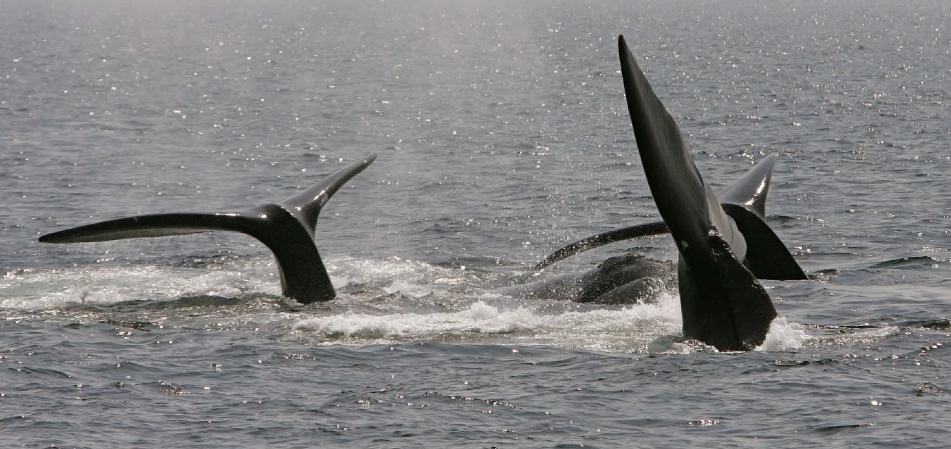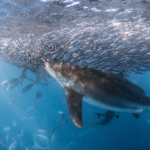Article Courtesy: washingtonpost.com | By: Chelsea Harvey | Originally Published: June 6, 2016 | Please click here for original article.
Above: Three North Atlantic right whale tails break the surface in Cape Cod Bay near Provincetown, Mass. Research has suggested that noise from shipping may influence the ability of right whales to communicate with one another. (Stephan Savoia/AP)
The world’s marine animals are up against some big challenges, including everything from climate change and ocean acidification to pollution and overfishing. And in the past several decades, conservationists have grown increasingly concerned about another threat, one that’s both pervasive and invisible in the water: the danger of sound.
Scientists and activists alike have pointed to a growing body of research suggesting that many marine animals rely on sound for communication, navigation and awareness of their surroundings — and that the noises generated by human activities, such as shipping, industrial work and military exercises, may be more disruptive to their natural habitats than we ever thought.
Now, the National Oceanic and Atmospheric Administration (NOAA) is helping to address these concerns with a new “strategy roadmap” — the first of its kind — for researching and managing ocean noise and its impact on marine life. The agency released the strategy in draft form last week and will leave it open for public comments through July.
Ocean noise can affect marine animals in a variety of ways — some of which scientists are only beginning to understand. Research has suggested, for instance, that noise from ships can decrease the ability of endangered right whales to communicate with one another, or that noise from seismic surveying can change the behavior of blue whales.
Much of the public concern has, in fact, centered on marine mammals, such as whales and dolphins. But NOAA marine ecologist Leila Hatch added that scientists now believe a wide variety of organisms may be affected by ocean noise, including shrimp, crabs, sea urchins and other invertebrates. But there’s still much that is poorly understood.
“It’s been taking a lot of investment by NOAA and by other federal agencies and by all of our academic partners to understand how animals should respond in very short timeframes to marine sound,” Hatch said. But the challenge, she said, is “understanding how animals are coping with the addition of sound over very large spatial scales — how are they coping with the addition of this type of stressor to an environment that has other things going on?”
Complicating the issue is the idea that climate change — which is already increasing the stress on marine animals enough through rising water temperatures, increasing acidification and changes in ocean circulation — may also cause the marine landscape to become even noisier. Oceanographer Walter Munk has pointed out that sound travels faster in warmer water, and that sound transmissions may travel faster and farther in a warming ocean. As a result, ocean noise is an even bigger concern when the ongoing effects of climate change are taken into account.
The new NOAA strategy aims at both a more comprehensive scientific understanding of the effects of ocean noise and the development of better tools for its management and mitigation.
“NOAA has actually had a presence for a long time trying to mitigate the impacts of ocean noise,” said Richard Merrick, NOAA’s director of scientific programs. He noted that under laws such as the Endangered Species Act and the Marine Mammal Protection Act, both of which have existed since the 1970s, the agency has been charged with the obligation to protect the animals listed under those acts and their habitats.
Previously, however, concerns related to ocean noise have generally been dealt with on a case-by-case basis, with the government adjusting individual projects as concerns arose. But increasingly, scientists are becoming aware that the issue is not that simple. “In truth, there are a whole bunch of projects going at at any one time, and they all have cumulative effects,” Merrick said.
In 2010, the agency’s administration charged it with developing a more progressive approach to understanding and dealing with ocean noise, Merrick said — a process that has involved discussions and collaborations between various NOAA entities, such as the fisheries and marine sanctuaries offices, and with other outside partners, such as industry groups, conservation organizations and the military.
The new strategy roadmap, which was released June 1, includes four overarching goals revolving around science, management, the development of assessment and other decision-making tools and public outreach.
“The Strategy Roadmap is not intended to be a prescriptive listing of program-level actions,” the strategy says. “Instead this document is intended to provide a cross-line office roadmap summarizing some of the essential steps that could be taken across the agency to achieve the strategy’s goals for more comprehensive management of noise impacts.”
NOAA is already working on developing some of these steps. Before the new document was released, NOAA began work on a project called CetSound, which involved the development of tools to help map whale, dolphin and porpoise distributions as well as the man-made underwater sounds in their environments. The agency is also hoping to work with other partner organizations to start compiling long-term datasets that can be used to inform models of the way sound permeates the ocean, Hatch added.
When it comes to managing ocean noise, advances in technology will likely be key, according to Hatch and Merrick. Some of these advances may piggyback on other environmental causes — for instance, technology that helps ships cut down on their greenhouse gas emissions may also be used to make them quieter.
The strategy is a positive step for NOAA, according to Michael Jasny, director of the Natural Resources Defense Council’s Marine Mammal Protection Project. In a recent blog post about the news, he noted that “under the new policy-rich, four-chapter strategy, NOAA would begin — finally — to manage noise as the pervasive ocean pollutant that it has become.”
But he added that “what is needed, plainly and soon, is a concrete implementation plan and a budget to achieve it. And while the strategy would give NOAA a true leadership role, it is largely silent on how NOAA will engage other relevant federal agencies, like the Department of Transportation, that are presently AWOL on the issue.”
According to Merrick, developing an implementation plan is the next step for NOAA, although Hatch added that this process may take up to a year. While that’s happening, the agency will collect the public comments submitted on the draft strategy and consider them when making updates to the document later this year.
“As always, real change requires public engagement,” Jasny wrote. “If we want the new Ocean Noise Strategy to become more than a paper tiger, we will have to demand it. But as a reflection of agency commitment, today’s announcement from NOAA is a major step forward.”






